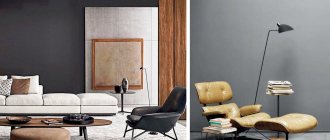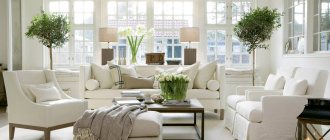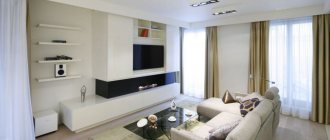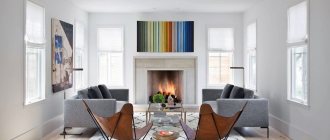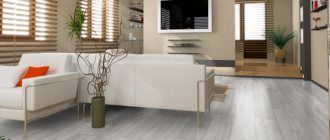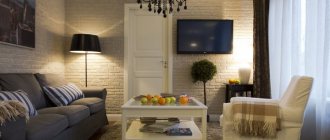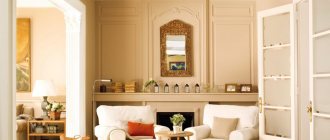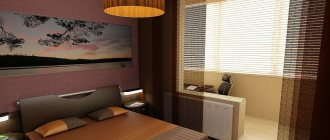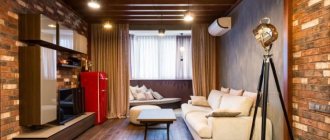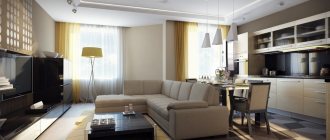Interior design styles have evolved over the past several centuries. Nowadays, there are hundreds of interior design styles. And the variety of subtypes of interior styles is simply amazing! Each concept follows its own canons, within which there is always room for creative ideas and fantasies.
Let's get acquainted with more than 100 interesting interior design styles, ranging from traditional to the most shocking and unusual.
Plants in the interior of a residential building. Selection rules, preferences
Plants play an important role in the interior of a residential building. They create coziness, “revive” the room, purify the air, fill it with phytoncides, and can also zone it. However, it is worth remembering a few fairly simple rules. The plant should fit harmoniously into the room in size; it should not take over the entire space, although it can act as an accent. Living plants should be placed carefully in bedrooms and children's rooms, remembering that they absorb oxygen at night. It is also worth remembering that the flora requires care, and if the owners are not ready for this, then you can get by with artificial copies.
Classic
The most popular style in which the interior of a residential building is decorated is classic. Its hallmarks are its attraction to light colors and traditional materials: wood, stone. Classic interiors are built according to the principles of symmetry, with a clear identification of the compositional center. Usually an invisible axis runs through the center of the room, relative to which a harmonious symmetrical composition is created. This style is characterized by the use of elements such as stucco, half-columns, pilasters, rosettes, expensive fabrics, furniture made from solid wood, and parquet. Typically, classics are characterized by the use of a large number of decorative elements: vases, paintings, sofa cushions, candlesticks, lamps. The classic involves central lighting in the form of a chandelier, most often a crystal one, and several additional light sources.
Furniture arrangement
Any type of interior of a residential building is impossible without furniture. When planning a home, you need to think about the arrangement of objects in accordance with zoning and the needs of people. The aesthetic factor also plays an important role. The usual way of distributing furniture along the walls is not always convenient and productive. Using furniture, you can adjust the shape of the room, which ideally should be made square. The main placement rules are as follows:
— proportionality and proportionality of objects must be observed;
— there should be enough space for transit between objects in the room, comfortable access should be provided to cabinets and shelves;
— you should choose the main object, for example, a sofa, fireplace or table, and build the composition of the room around it. Don’t be afraid to move an object into the middle of the room, because complicating the route of movement can create new scenarios for using the room. Before arranging furniture, you need to carefully analyze the lifestyle of its owners and consider all possible options in order to calculate the space for each function.
Grunge
All photos of the project Aristocratic grunge in the interior of an apartment in the historical center of Moscow
The grunge interior style, which originated in the 19th century in France, is rarely used in the design of a modern apartment. But it is precisely this fact that allows us to appreciate its exclusivity. One could say that grunge is an ironic and sophisticated interpretation of country style by the French aristocracy.
Harmony of aristocratic and rural life
All photos of the project Kitchen design project with yellow bar stools
The slight spirit of desolation hovering in the French estate, which seemed to persist for decades, leaves an indelible imprint on the grunge interior.
All photos of the project Dining room in grunge style with designer wallpaper and coffered ceiling
The cracked walls, touched by mold and decay, with traces of exquisite decor, are masterfully imitated by the design of the designer wallpaper. Furniture with a noble patina is distinguished by good solidity and gives the interior composition a flair of antiquity.
All photos of the project Fireplace room in grunge style with a corner sofa and coffered ceiling
Grunge is characterized by the use of vintage interior design elements from the French province in the form of barn walls made of aged brick, wooden beams and worn plank floors.
Boudoir with designer furniture
Such a deliberately careless base is in amazing harmony with antique pieces of furniture and decor, elegant designer furniture and classic textiles.
Interior concept
The literal translation of the word "interior" from French means "internal". This concept today includes not only decoration, but also planning, zoning, and the development of a convenient arrangement of furniture and objects in accordance with human behavioral scenarios. When the need arises to create the interior of a residential building, the first thing that comes to mind is to turn to specialists. The design of living space is done by designers, decorators, and sometimes architects. But still, more often than not, people decorate their home on their own, listening a little to the advice of professionals. Therefore, interior design often comes down to the arrangement of furniture and the choice of wall color. And the interior is a thoughtful organization of living space, which should contribute to normal human life.
Color in the interior
When creating a project on the theme “Interior of a residential building,” you need to make important decisions about the color filling of the room. Psychologists have proven that color has a great influence on a person’s mood and well-being; this must be taken into account when choosing color options for an apartment. It is also worth remembering that a person will spend a lot of time in these rooms, and nothing should irritate or depress him. There is a rule according to which it is not recommended to use more than 3 colors in one room. 60% of surfaces should be painted in a primary color, most often a discreet and neutral color. 30% of surfaces are made in a second color; it should be in harmony with the main one, but differ significantly from it. The easiest way is to choose two tones that are adjacent on the color wheel. 10% of the room is decorated in a contrasting color scheme to the second one. For example, curtains in the interior of a residential building can be a bright accent; sofa cushions or large decorative items can perform the same functions.
Art Deco
All photos of the project Luxurious kitchen-living room in Art Deco style
Chocolate brown kitchen with glossy Art Deco style facades
When you mention Art Deco, the first thing that comes to mind is expensive Gatsby-style parties with pyramids of champagne glasses, a chocolate fountain, the rustling of silk and the chime of crystal.
Art Deco bedroom
The direction of the “golden 20s”, which arose in the era of prosperity between the two world wars of the 20th century, strives to amaze even the most sophisticated guest with its luxury.
How is Art Deco different from classics?
All photos of the project Luxurious bathroom in Art Deco style
- More strict geometry.
A play of simple and modern geometric shapes: rhombuses, rings, ovals and rectangles. - Strong color contrast.
The interior palette is based on the contrast of deep black and perfect white with accents of rich shades of gold, metallic pink, burgundy, lilac and blue tones. - Atmosphere of glamor.
Glossy furniture facades, the shine of crystal and polished marble, and the shimmer of stained glass create a glamorous ambiance. - Exotic motives.
The decor includes Aztec and African patterns, fantasy images of plants, animals, insects and birds, and unusual souvenirs brought from different countries.
Principles of interior planning
When creating the interior of a residential building, you should remember the basic principles of design and layout. First of all, the room must meet the requirements of ergonomics and anthropometry. That is, it should be suitable in size for a person, allowing him to engage in usual activities without spending extra resources and without experiencing discomfort. Also, any design rests on “three pillars”: benefit, function and beauty. Throughout the long history of design, there have been periods when the focus was solely on beauty, for example, in the Baroque era, or only on functionality, for example, in the minimalist style. But modern man strives for a balance of aesthetics and practicality, and also strives to comply with the rule of environmental friendliness. A competent description of the interior of a residential building often mentions the main compositional principles that must be taken into account when decorating a home. This is integrity, harmony, balance, the presence of a compositional center, accents and rhythm. Any interior consists of three groups of elements: the building shell, i.e. walls, floor, ceiling, windows; items, i.e. furniture, equipment; functional processes, i.e. everything that allows a person to perform the necessary actions in the room, and also creates emotions and atmosphere.
Room zoning
When designing a living space, it is necessary to think through functional areas at the design stage. It is based on three principles:
- Age. Separate spaces are necessary for different generations of residents.
- Temporary. Traditionally, nighttime and daytime activities are separated.
- Functional. The premises must meet the individual needs and lifestyle of all family members.
The layout of the house should be determined before decorating begins. You should carefully consider places to sleep, highlight public and utility areas, and consider the placement of communications and technical equipment.
Minimalism
A type of modern style is minimalism. As the name implies, it seeks to remove unnecessary objects from the room as much as possible. First of all, this applies to decorative items. There is no place for carpets, chandeliers, or vases. The minimalist interior of a residential building makes maximum use of everything built-in: appliances, lighting fixtures. Many pieces of furniture are “hidden” in simple surfaces. For example, a reclining bed or table is a popular minimalist technique. This style is also characterized by a small number of colors; the most popular tones are white, gray and black. To add dynamics to the interior, bright accents can be used, for example, a yellow chair in a gray room.
Modern
The always current interior design of a residential building is the Art Nouveau or Art Nouveau style. It is characterized by a large number of curved lines and plant motifs. The pinnacle of this style was the interiors of A. Gaudi and F. Shekhtel. This style is a fierce opponent of symmetry; straight lines are not typical here. Everything is built on the play of shades and nuances. This style is characterized by the use of a large number of details, ornaments, an abundance of textiles, it can combine elements from other styles, the main thing is harmony and mood. A solution in the Art Nouveau style can be bright, using bold color solutions, or it can be subtle and nuanced.
Historicism
Classic styles in the interior of a residential building are divided into several eras, called “great styles”. These are classicism, baroque, rococo and empire. The most luxurious and elaborate is Baroque, we can see it in the royal palaces of Louis the Fourteenth. He is characterized by the use of a large number of carved, gilded details, velvet in upholstery and curtains, and paintings. A more restrained and refined rococo, characteristic of the times of Louis XV, is distinguished by an almost complete absence of straight lines. It, like all historical styles, retains a tendency towards symmetry and the use of natural materials. Classicism is the most famous and popular style in the design of aristocratic homes. He is characterized by a desire for brevity and rigor of ancient traditions. A variant of classicism was the imperial style - Empire, which departs from the canonical straight and simple lines. Empire style is luxury and scope. All historical styles require rooms with high ceilings and large volumes.
Ethnics
Designers often suggest decorating living spaces in ethnic style. The advantage of this style is its endless variety. These may be national versions of the classics, for example, English or American style. And also cozy country options, for example, Provence, Austrian chalet. Although most often ethnicity refers to interiors in the spirit of India, Morocco, Mexico, China, Japan, and Africa. The beauty of ethnic style is that it allows you to create a bright and individual image. It is characterized by the use of traditional items of a certain territory or country.
Light in the house
Man is a solar creature, and his mood and well-being depend on the illumination of his home; this should be remembered when creating the interior of a residential building. Lighting can be natural or artificial. In the first case we are talking about windows. If possible, it is better to choose houses with windows facing different sides, and it is desirable that the openings are large enough. But in any case, it will not be possible to do without artificial lighting. When planning it, you need to think through various lighting scenarios that will help residents live and act comfortably. Traditionally, there is general, functional and accent lighting. The purpose of general light in a room is to maintain a sufficient level of illumination. Traditionally, its sources are located on the ceiling; this can be a central chandelier or several lamps around the perimeter of the ceiling. Today, in modern interiors, designers are increasingly abandoning the central lamp, and prefer several lamps that maintain the overall level of illumination. Functional light sources are installed above areas where residents will perform some activity: reading, cooking, working. In such places, table or pendant lamps, sconces, and floor lamps are usually installed, preferably with the ability to change the angle of incidence of the beam. Accent light is designed to highlight some elements of the interior, for example, paintings. Small lamps and spots are used for this.
Loft
All photos of the Loft project with neoclassical elements in the interior of the living room apartment in the Moscow residential complex "Solnechny Bereg"
The loft style is well suited for spacious apartments and penthouses with panoramic windows and high ceilings. The hallmark of the style is brickwork and concrete.
Loft style kitchen
Just half a century ago, loft spaces were considered budget housing, which was equipped on the territory of former factories and factories. Loft apartments did not require finishing at that time. Brickwork, concrete, beams, pipes and other attributes of industrial interiors were preserved unchanged. Future residents only had to get the necessary furniture. So gradually, on the basis of the premises of empty industrial workshops, a new direction arose.
Office design in loft style
Today, living in a loft is prestigious and not as affordable as before. Elements of this style can be introduced into any modern space. To create a loft interior, you will need to minimize the number of internal partitions.
Modernity
The concept of “modern style” is very broad. It has an endless number of variations, with ethnic, historical, functional shades. But most importantly, the modern interior of a residential building should be easy to maintain, comfortable for life and in keeping with the spirit of the times. It is characterized by a mix of objects of different styles, characterized by straight lines, a large number of simple surfaces, without patterns or textures. Also, modern style requires a minimum of decor, which would take time to maintain and overload the interior. Premises in this style are created so that a person can relax and unwind. But the interior should be as comfortable as possible, i.e. it must take into account all functions. Therefore, it often uses transforming items that perform several functions simultaneously.
